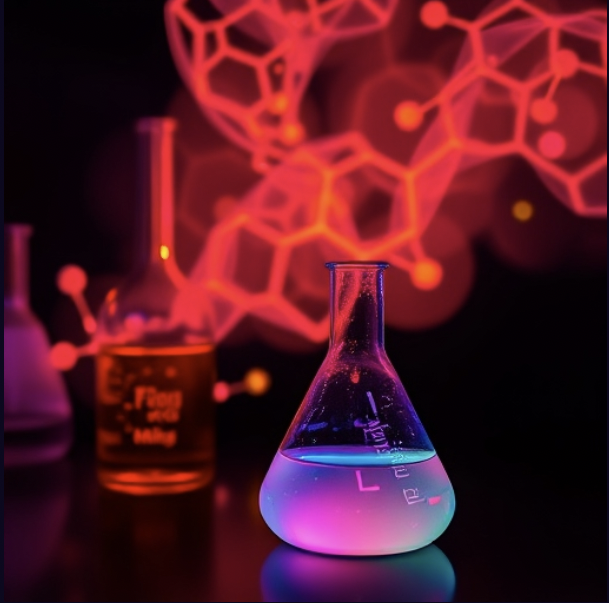
SMol
MOLECULAR PROBES
Scientific context and objectives
The SMol team is focused on the design, synthesis and validation of smart molecular probes, and envisages their deployment in a wide range of applications including fluorescence imaging, phototherapy, early diagnosis of genetic diseases and environmental analysis.
A common scientific core is the use of fluorescence techniques as a means of detecting these molecular objects in complex analysis media (e.g. biological samples, in vivo models, environmental matrices, etc.). To achieve these objectives, the members of SMol draw on recognised expertise in fluorescent organic dye synthesis, molecular photophysics, bio(in)organic chemistry and molecular and cell biology. In addition, two members of SMol are also involved in the PACSMUB analysis platform (acting as deputy director and providing spectroscopic services).
Team members

Team leader: Pr. Christine GOZE (PR)
- Dr. Richard DECREAU (MCF)
- Dr. David MONCHAUD (DR CNRS)
- Dr. Christine STERN (MCF)
- Romain BOIDOT (IR CGFL))
- Marc PIROTTA (AJT UBE)
- Non-permanents : liste
Research topics
Topic 1: Development of fluorescent probes for imaging applications
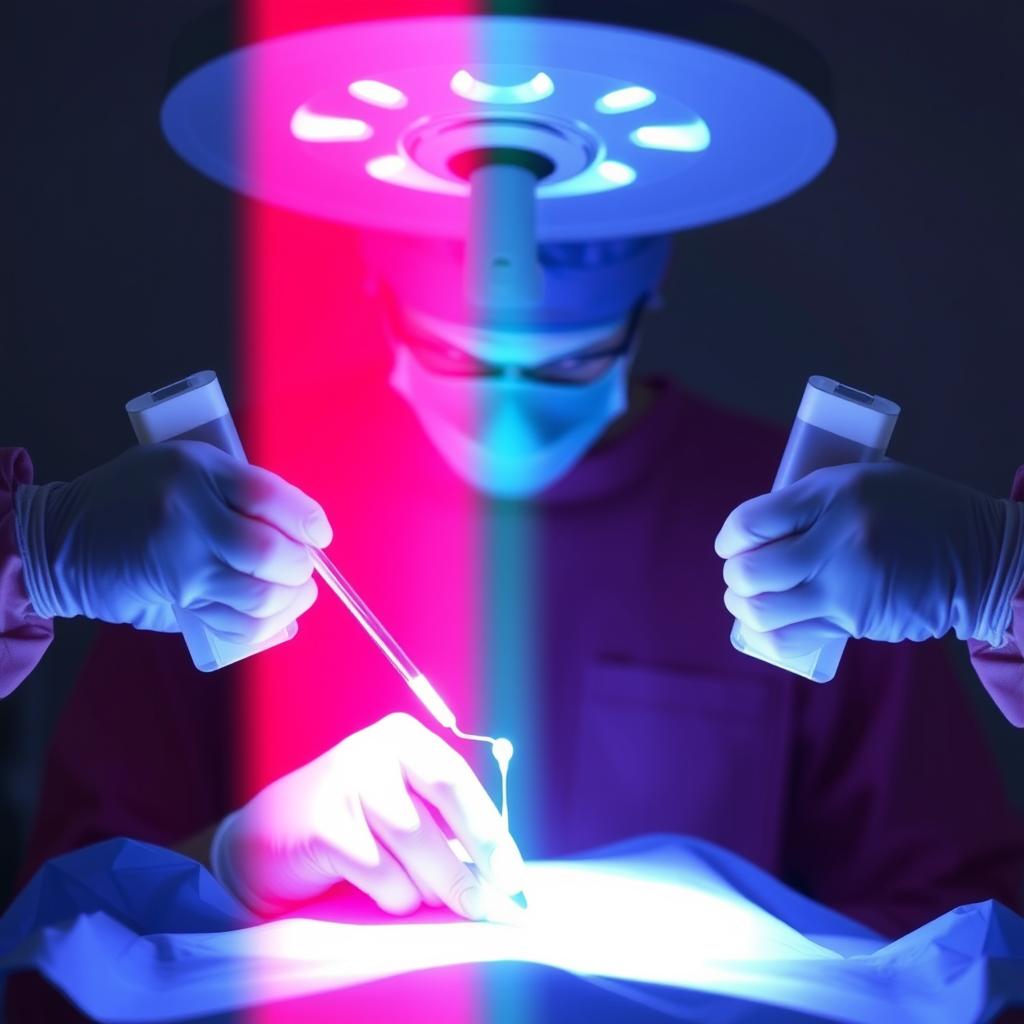
Find out more about our research topics :
Fluorescent probes for Fluorescence-Guided Surgery (FGS)
Fluorescence-guided surgery (FGS) is an innovative technique, particularly in the field of cancer, which enables surgeons to better visualize specific structures invisible to the naked eye, in particular tumour cells, with greater precision, while preserving the integrity of healthy tissue as much as possible. In this context, we are working on the development of organic fluorophores optimised for FGS, in particular aza-boro-dipyrromethene derivatives, which are brilliant structures that are chemically and photochemically stable, and whose photophysical properties are suitable for imaging applications (absorption and emission in the near infrared range). In order to optimize them for the targeted applications, various molecular approaches are being developed:
– Optimizing their solubility in water by post-synthetic functionalization of the boron atom
– Shifting of their fluorescence properties to the NIR-II range (1000-1700 nm), resulting in greater depth and sensitivity.
– Combining fluorophores with polyazamacrocyclic ligands (acting as radiometal chelating agents) within the same structure, enabling bimodal imaging to be carried out and benefiting from the advantages of each of the techniques
– Optimizing their photophysical properties, particularly the lifetime of the excited state, in order to develop fluorophores suitable for fluorescence lifetime imaging, which is much more sensitive than fluorescence imaging.
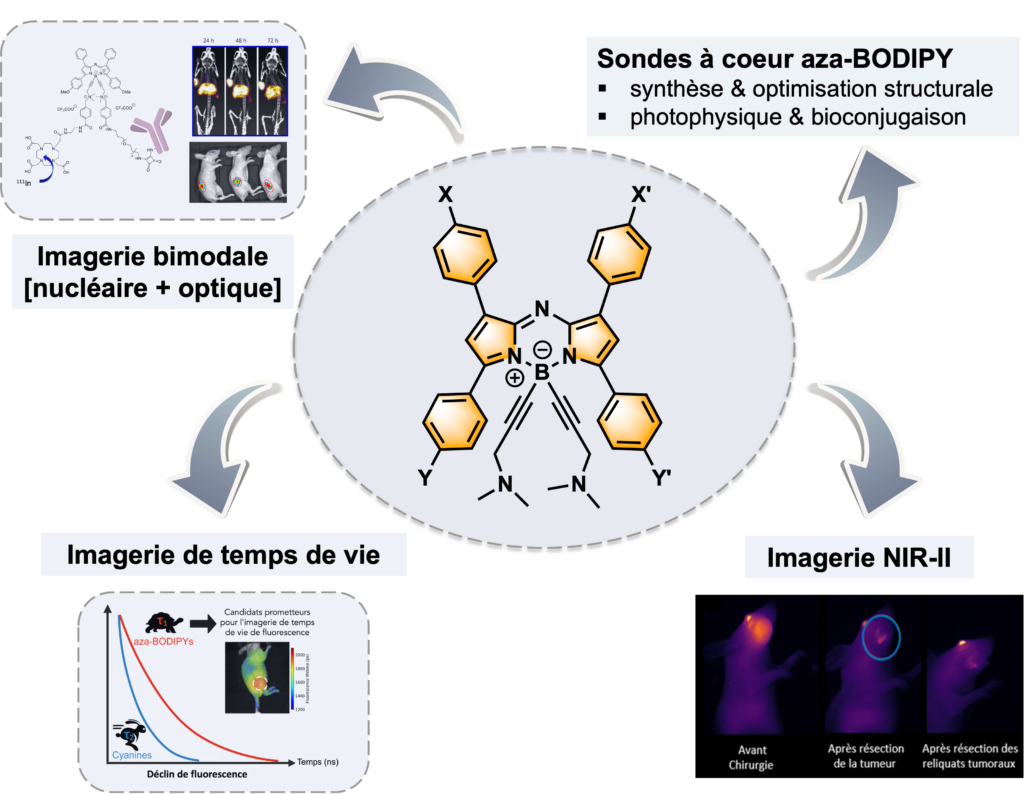
Selection of publications
- Development of an Immuno-SPECT/Fluorescent Bimodal Tracer Targeting Human or Murine PD-L1 on Preclinical Models. M. Privat, A. Massot, F. Hermetet, H. Al Sabea, C. Racoeur, N. Mabrouk, M. Cordonnier, M. Moreau, B. Collin, A. Bettaieb, F. Denat, E. Bodio, P.-S. Bellaye, C. Goze, C. Paul. Journal of Medicinal Chemistry (2024), 67, 2188-2201
- NIR-II Aza-BODIPY Dyes Bioconjugated to Monoclonal Antibody Trastuzumab for Selective Imaging of HER2-Positive Ovarian Cancer. A. Godard, G. Kalot, M. Privat, M. Bendellaa, B. Busser, K. David Wegner, F. Denat, X. Le Guével, J.-L. Coll, C. Paul, E. Bodio, C. Goze, L. Sancey. Journal of Medicinal Chemistry (2023), 66, 5185-5195
Topic 2: Smart fluorescent probes for biosensing and environmental analysis applications
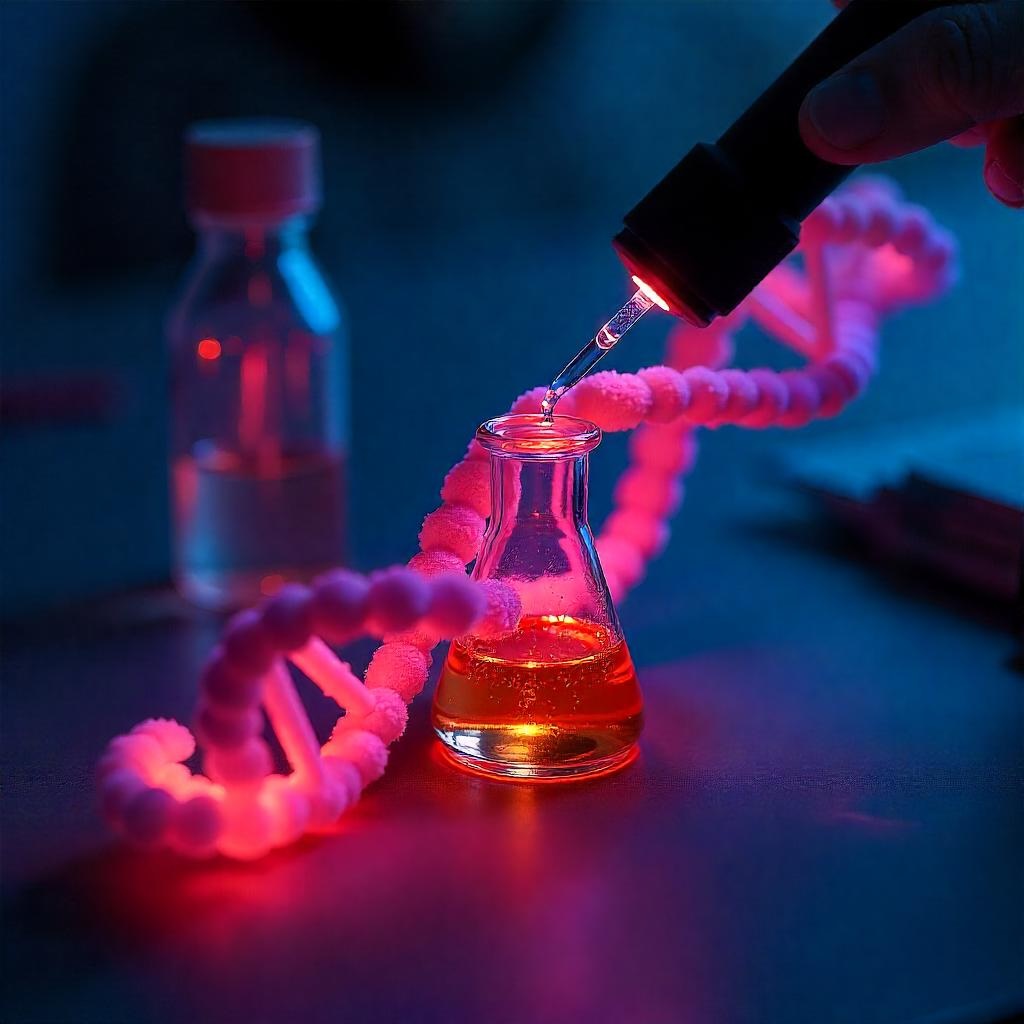
Find out more about our research topics :
Conventional fluorogenic probes
Conventional fluorogenic probes refer to fluorophores whose one functional group acts as a fluorescence switch “OFF-ON” depending on its masking/unmasking state (typically, an amino or hydroxyl group found in aniline- or phenol-based fluorophores, protected with a chemical moiety which is able to be removed by the targeted analyte). Therefore, when the probe reacts with the targeted analyte, an effective deprotection reaction of functional group occurs and fluorescence enhancement is observed (fluorogenic “OFF-ON” response). Our recent contribution in this field is focused on the assessment of novel photo-active architectures in order to design fluorogenic substrates responsive to microbial enzymes (reductases and peptidases). The main goal is to obtain more effective tools for bacterial detection, usable in diagnostic microbiology. Original fluorogenic scaffolds belonging to the diketopyrrolopyrrole (DPP) or hemicyanine family have been recently developed and evaluated in the framework of a long-term collaboration with R&D Microbiology department of bioMérieux company.
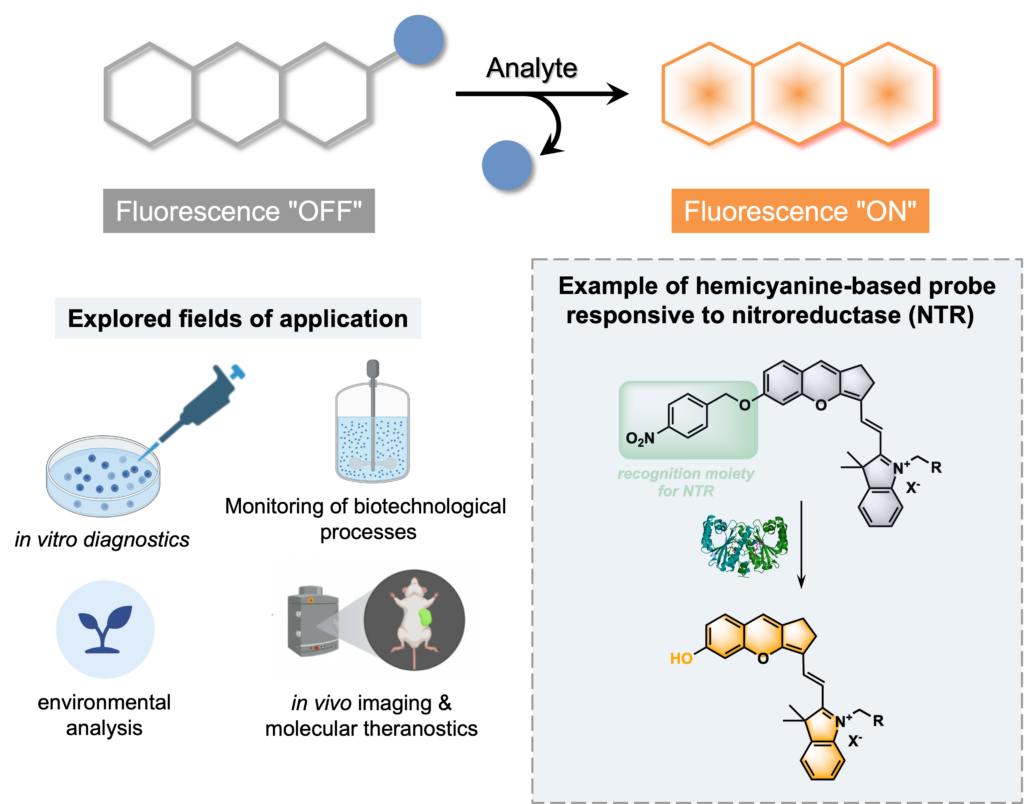
Emerging molecular approaches in fluorogenic (bio)detection: covalent-assembly and molecular disassembly
In order to provide high-performance molecular probes suitable for facing current and upcoming challenges in (bio)analysis, we have been exploring for a decade, a cutting-edge approach kwown as “covalent-assembly”, particularly well suited for obtaining optimal detection sensitivity. This approach is based on the design and use of “caged” molecular precursors that can be readily in situ converted (i.e., in the medium to be analyzed) in fluorescent heterocycles, through domino reactions effective in aqueous media and triggered by the targeted analyte. Several years have been devoted to the development, optimization and validation of an original fluorogenic molecular cascade leading to in situ formation of bright pyronin dyes emitted above 550 nm, under the action of an enzymatic stimulus. The efficiency of this enzyme-triggered domino process has been recently demonstrated in the context of living cells having a lysosomal b-galactosidase activity. This proof of in cellulo synthesis of organic fluorophore from an enzyme-activatable probe, is the key stone of novel molecular (photo)theranostic approaches currently explored in our research group. Interestingly, this probe design principle has also been implemented to environmental and NRBC applications with the detection of toxic pollutants (e.g., cyanide ions and mercuric cations Hg(II)) and organophosphorus nerve agents. However, the “covalent-assembly” principle is limited to analytes bearing a marked reactivity in covalent chemistry. In order to manage the detection of non-reactive anions, we have also explored an alternative approach based on metal decomplexation and molecular disassembly processes, recently proposed by the group of Prof. Felix Zelder (University of Zurich). Its implementation to the fluorogenic detection of biological phosphates is currently considered.
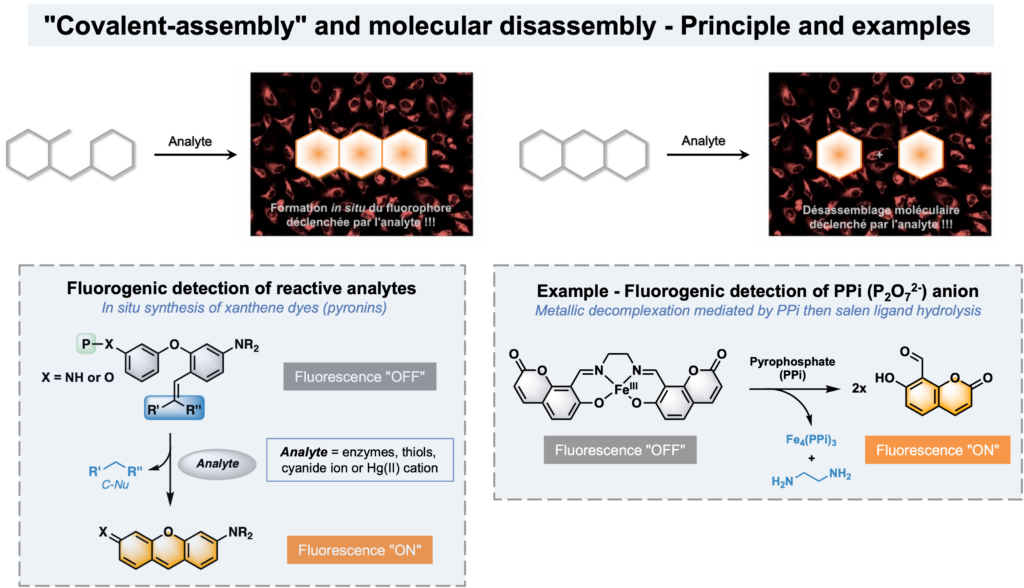
Multifunctional ligands for alternative nucleic acid structures
Our society needs new therapeutic approaches to address the global aging of the population and the relentless growth of associated diseases, particularly cancers and neurodegenerative disorders. Recent therapeutic advances have been made possible by the development of sequencing technologies, which has enabled increasingly precise genotyping of genetic diseases and thus the identification of markers with high strategic potential. These advancements have paved the way for a precise targeting of the genetic deregulations underlying these diseases, leading to the advent of precision medicine. However, sequencing only allows for the identification of genetic targets, and to date, the selective targeting of specific DNA sequences with small molecules remains elusive. An alternative to targeting DNA sequences is currently gaining significant popularity: targeting DNA structures, particularly alternative DNA structures. Indeed, beyond the double helix (or duplex), DNA can locally adopt various structures comprising not two (like in the duplex DNA, or B-DNA) but three or four strands (such as triplexes (H-DNA), DNA junctions (C- and S-DNA), quadruplexes (G- and I-DNA), etc.). These structures possess much richer 3D architectures than duplexes, allowing for more precise targeting. Over the past few years, our contributions in this field have been manifold: we have shown that G-quadruplexes and three-way DNA junctions play important roles in the pathological mechanisms linked to cancers and neurodegenerative diseases; we have also developed smart molecular tools that are used as ligands, imaging probes, and molecular baits to gain increasingly precise information about the existence, biological prevalence and functional relevance of these structures in the genetic deregulations underlying these pathologies.
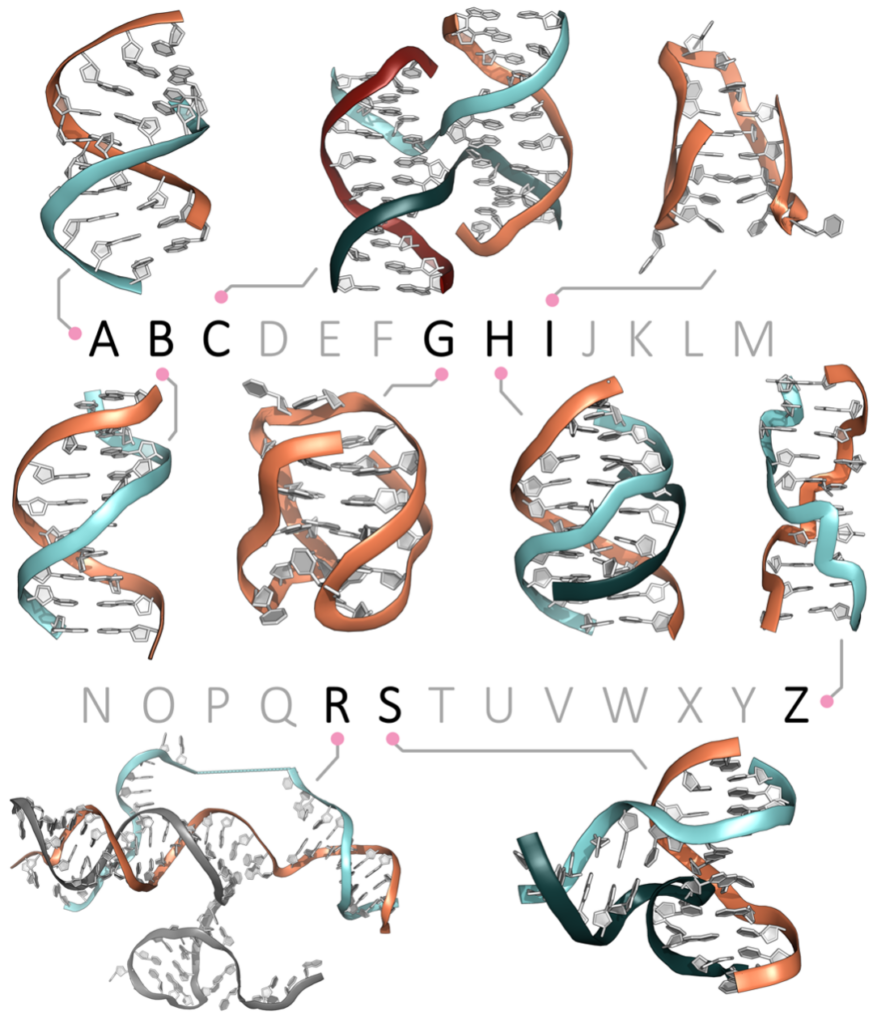
Selection of publications
- Fluorogenic detection of cyanide ions in pure aqueous media through intramolecular crossed-benzoin reaction: limitations unveiled and possible solutions. V. Gaumerd, Y. Capello, Q. Bonnin, P.-Y. Renard, A. Romieu. Analyst (2025), 150, 168-176
- Structural Optimization of Azacryptands for Targeting Three-Way DNA Junctions. A. Pipier, T. Chetot, A. Kalamatianou, N. Martin, M. Caroff, S. Britton, N. Chéron, L. Trantírek, A. Granzhan, D. Monchaud.Angewandte Chemie International Edition(2024), 63, e202409780
- Template-assembled synthetic G-quartets (TASQs): multiTASQing molecular tools for investigating DNA and RNA G-quadruplex biology. D. Monchaud. Accounts of Chemical Research(2023), 56, 350-362
- Interactions of small molecules with DNA junctions. K. T. McQuaid, A. Pipier, C. J. Cardin, D. Monchaud. Nucleic Acids Research 2022, 50, 12636-12656
- Identifying G-quadruplex-DNA–disrupting small molecules. J. Mitteaux, P. Lejault, F. Wojciechowski, A. Joubert, J. Boudon, N. Desbois, C. P. Gros, R. H. E. Hudson, J.-B. Boulé, A. Granzhan, D. Monchaud. Journal of the American Chemical Society (2021), 143, 12567-12577
- Deeper insight into the protease-sensitive “covalent-assembly” fluorescent probes for practical biosensing applications. K. Renault, S. Debieu, J.-A. Richard, A. Romieu. Organic & Biomolecular Chemistry (2019), 17, 8918-8932
Topic 3 : Technology development in molecular biology
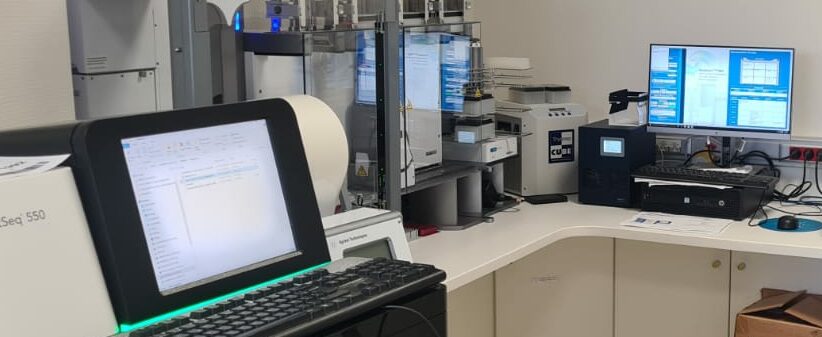
Find out more about our research topics :
Molecular Biology and sequencing
The Molecular Biology Unit of the CGFL is a routine molecular diagnostics laboratory. However, its research activities focus on technological development based on new sequencing technologies and biomarker research.
In particular, the laboratory is focusing on 3rd generation sequencing using nanopores, which enables the sequencing of native nucleic acids, i.e. as they are present in cells. The first application developed and published in January 2025 demonstrated the use of this type of sequencing to detect alterations responsible for genetic predisposition to cancers, including breast, ovarian, digestive, pancreatic and prostate cancer.
The laboratory currently has two projects underway:
Study circulating tumour DNA for monitoring, follow-up of residual disease and screening for solid cancers using a simple blood test.
Developing a rapid detection kit for alterations in breast cancer predisposition genes, to provide a result in 2 days instead of 3 to 6 months.
The laboratory is also open to any development enabling partners to enrich their research with sequencing techniques.
Selection of publications
- Nanopore adaptive sampling accurately detects nucleotide variants and improves the characterization of large-scale rearrangement for the diagnosis of cancer predisposition. S. Chevrier, C. Richard, M. Mille, D. Bertrand, R. Boidot. Clinical Translation Medicine (2025), 15, e70138
- Clinical evaluation of a low-coverage whole-genome test for detecting homologous recombination deficiency in ovarian cancer. R. Boidot, M. G. B. Blum, M.-P. Wissler, C. Gottin, J. Ruzicka, S. Chevrier, T. M. Delhomme, J. Audoux, A. Jeanniard , P.-A. Just, P. Harter, S. Pignat, A. González-Martin, C. Marth, J. Mäenpää, N. Colombo, I. Vergote, K. Fujiwara, N. Duforet-Frebourg, D. Bertrand, N. Philippe, I. Ray-Coquard, E. Pujade-Lauraine, PAOLA-1/ ENGOT-ov25 Study Group.European Journal of Cancer (2024), 202, 113978
- Durable response of lung carcinoma patients to EGFR tyrosine kinase inhibitors is determined by germline polymorphisms in some immune-related genes. L. Dalens, J. Niogret, C. Richard, S. Chevrier, P. Foucher, B. Coudert, A. Lagrange, L. Favier, V. Westeel, S. Kim, O. Adotevi, C. Chapusot, L. Martin, L. Arnould, C.-G. Kaderbhai, R. Boidot. Molecular Cancer (2023), 22, 120
Ongoing projects
We benefit from the support of various funding agencies (ANR, Ligue contre le Cancer, MITI CNRS, Horizon Europe programme, etc.) and the BFC region via FEDER funding and the INTHERAPI Graduate School. We also devote part of our activities to technology transfer initiatives carried out with the support of SATT SAYENS, CNRS Innovation or in partnership with start-ups (CHEMFORASE, FLUONIR, SON) or internationally renowned companies (Merck KGaA and Strem Inc.).